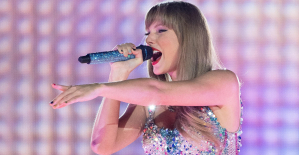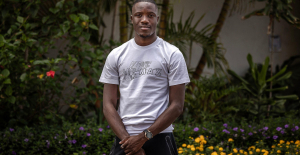Uzbeki-what? If Uzbekistan hasn't been on your list as a possible travel destination - then you're like me. I have never traveled to the Orient or Central Asia, my knowledge of the region is shamefully limited. The diversity of this country is all the more surprising and fascinating.
The reason for the trip is a large show of archaeological treasures from Uzbekistan, which will be shown from May 3, 2023 in the James Simon Gallery in Berlin and in the New Museum (a report on this will follow at WELTHistory).
But the supporting tourist program and the many everyday details are just as fascinating. Our young guide Farouk, who sometimes answers the questions of the ignorant westerner with a mild but never arrogant smile, is very helpful in getting to know this strange world.
We experience a melting pot of cultures, because here was a station of the old Silk Road, the ancient trade route that connected China with the Mediterranean Sea. In addition, various rulers and conquerors such as Timur Lenk and Alexander the Great have left their mark over the centuries. Accordingly, Greek, Arabic, Russian, Indian and Chinese influences can be felt everywhere.
Uzbekistan is a country in transition, on the move. Since 2016, when Shavkat Mirziyoyev took office as president, the previously isolated ex-Soviet republic has opened up to foreign investors and tourists. A lot of money is spent on this, and there is brisk construction activity in many places. This does not happen without collateral damage: Old buildings and residents have to make way for very wide new main roads, not everything fits together.
Some of the huge new buildings, often decked out with plenty of colorful LEDs, look like spaceships that have landed in what was previously a rather plain setting. Great importance is attached to the representative character of the architecture: the original design of the airport building is immediately apparent upon arrival in Samarkand. It looks like a giant open book. More precisely: The book of Ulugh Beg, an important medieval astronomer and governor of Samarkand, as Farouk explains.
Away from the new boulevards, the Central Asia newcomer is reminded of TV pictures from Beirut or Kabul. The houses have tin roofs, power lines are sometimes draped in an original and rustic way. The cars are mostly painted white because the interior doesn't get as hot in the summer heat, says Farouk. Many of them fill up with natural gas instead of petrol. Dog catchers go hunting here and there, not far away they just catch a miserable half-breed, there is loud barking.
As a European, you seem to be from another planet, even to many locals. They look at the visitor curiously, greet them with "Salam aleikum" and ask if you would like to take selfies with them.
Western brands and logos have established themselves surprisingly consistently, even in more remote regions. Cola, Fanta and Sprite can be found everywhere at gas stations and kiosks (although the taste is a bit different than usual, somehow milder). The familiar selection of chocolate bars is also available - but also many local variants, labeled in Cyrillic. A holdover from the Soviet era that can still be seen everywhere alongside Latin letters.
There is still no sign of the big US burger chains, but there are plenty of local shish kebab and burger stands.
In addition to soft drinks, alcohol is also easy to get, in many places you can see "AlcoMarkets", surprisingly Uzbekistan is a wine country. Farouk recommends the Bagizagan. It is grown in the town of the same name near Samarkand. However, after club visits, Jägermeister Red Bull is more popular with young people, says Farouk with a laugh. Who would have expected this?
Islam is not the state religion, everyone can be blessed according to their own style, and many women do not wear a headscarf. Nevertheless, the country is definitely Muslim: In some hotel rooms, a sticker on the bedside table points in the direction of Mecca (and Bagizagan is not served in these houses either).
At 5 a.m. in the morning, the muezzin calls loudly from the mosque next door. No problem, we want to get up early anyway and start with the first big highlight, Registan Square, an ensemble of three Koranic schools built between the 15th and 17th centuries.
The size and the opulent, detailed, colorful decorations are breathtaking. The first thought: Wow! The second: It is reminiscent of images of magnificent Iranian buildings and India at the same time - was this ensemble the inspiration for the Taj Mahal? Absolutely, says the expert: during his campaigns of conquest, ruler Timur Lenk brought architects and artists from Persia to Samarkand, whose buildings in turn became models for his successors and neighbors. One of Timur's descendants was Babur, who founded the Mughal Empire in India.
The Leaning Tower of Pisa is also discussed, but rather in jest, because the minarets on the Registan are also quite out of whack, probably due to some earthquakes. A number of other ancient and medieval buildings also impress; no wonder, the old town was included in the UNESCO World Heritage List, as were some of the other stations in Uzbekistan.
By car we head south-west, the destination is Bukhara, in whose historic center there are also a number of works of art to be admired, and where the picturesque summer residence of the last Emir Alim Khan is located. Peacocks roam free and flap their wheels in the early 20th-century gardens of the property.
However, the several-hour drive on the motorway on this section is more for the adventurous. A number of potholes have to be avoided, which doesn't stop many of the other drivers from their badly sporty driving style. Not for the faint-hearted, professionals therefore recommend the railway instead.
In the "Old Bukhara" restaurant, which is popular with tourists and locals alike, we enjoy delicious food, where the diverse influences of different cultures can be experienced: First, several salad variations, including the Uzbek version of tabbouleh, which tastes more lemony than the Lebanese version.
Stuffed vine leaf rolls are served, surprisingly not filled with cold rice as in Greece, but with hot minced meat. There are also dumplings filled with cheese and spinach, which in turn are reminiscent of Turkish gozleme. A soup with dumplings, which is also popular in Russia, is followed by the main course with plenty of grilled lamb, tomatoes, aubergines, potatoes and flatbread. Wonderful! For dessert: sumalak, a sweet wheat-based paste that tastes like malt candy and is traditionally served at the beginning of spring.
We continue through hilly, rugged desert and steppe to Termez, in the very south of the country on the border with Afghanistan. Buddhist cave monasteries from the second century were uncovered there, and the remains of a Buddha figure that was excavated here can also be seen in Berlin.
At the end of the trip, another big contrast: A good one-hour flight takes you from the province to the capital, Tashkent. There is also brisk construction activity in the metropolis, and new skyscrapers are rising. We see a mix of wide thoroughfares with prefabricated buildings from communist times, large new government buildings, historical buildings and monuments.
An absolute must is the Chorsu Bazaar, one of the largest and oldest bazaars in Central Asia, which was already known in the Middle Ages. In the center is a large dome containing countless butcher stands and vendors of herbs and spices, vegetables and fruits.
The dome is surrounded by a labyrinthine area full of alleys, passageways, market stalls, tents and halls. Carpets, towels, crockery, groceries, the list of goods on offer is endless. It's easy to get lost here, it's crowded and noisy, people are bustling about, and the negotiations are tough. Goods are unpacked and packed and repacked, there are so many impressions that you almost get dizzy. Craziness!
A number of grill masters and snack vendors are at work in a food court, it smokes and hisses, a lot looks inviting and smells wonderful. Others - like a stack of cooked lamb heads - probably not. The Uzbek national dish is served in large pans: Plov, which is primarily rice with meat. At first glance, it reminds Europeans of paella.
The flight home is much too early, there was still so much to discover. But there will be a reunion with Uzbekistan in May - when the Silk Road is extended to the Berlin Museum.
Travel information for Uzbekistan: uzbekistan.travel/de
Participation in the trip was supported by the Uzbekistan Art and Culture Development Foundation. You can find our standards of transparency and journalistic independence at axelspringer.com/de/Werte/downloads.

 Sydney: Assyrian bishop stabbed, conservative TikToker outspoken on Islam
Sydney: Assyrian bishop stabbed, conservative TikToker outspoken on Islam Torrential rains in Dubai: “The event is so intense that we cannot find analogues in our databases”
Torrential rains in Dubai: “The event is so intense that we cannot find analogues in our databases” Rishi Sunak wants a tobacco-free UK
Rishi Sunak wants a tobacco-free UK In Africa, the number of millionaires will boom over the next ten years
In Africa, the number of millionaires will boom over the next ten years WHO concerned about spread of H5N1 avian flu to new species, including humans
WHO concerned about spread of H5N1 avian flu to new species, including humans New generation mosquito nets prove much more effective against malaria
New generation mosquito nets prove much more effective against malaria Covid-19: everything you need to know about the new vaccination campaign which is starting
Covid-19: everything you need to know about the new vaccination campaign which is starting The best laptops of the moment boast artificial intelligence
The best laptops of the moment boast artificial intelligence Bitcoin halving: what will the planned reduction in emissions from the queen of cryptos change?
Bitcoin halving: what will the planned reduction in emissions from the queen of cryptos change? The Flink home shopping delivery platform will be liquidated in France
The Flink home shopping delivery platform will be liquidated in France Bercy threatens to veto the sale of Biogaran (Servier) to an Indian industrialist
Bercy threatens to veto the sale of Biogaran (Servier) to an Indian industrialist Switch or signaling breakdown, operating incident or catenaries... Do you speak the language of RATP and SNCF?
Switch or signaling breakdown, operating incident or catenaries... Do you speak the language of RATP and SNCF? Who’s Who launches the first edition of its literary prize
Who’s Who launches the first edition of its literary prize Sylvain Amic appointed to the Musée d’Orsay to replace Christophe Leribault
Sylvain Amic appointed to the Musée d’Orsay to replace Christophe Leribault Jeremy Allen White to play Bruce Springsteen for biopic
Jeremy Allen White to play Bruce Springsteen for biopic In Los Angeles, Taylor Swift hides clues about her new album in a library on the street
In Los Angeles, Taylor Swift hides clues about her new album in a library on the street Skoda Kodiaq 2024: a 'beast' plug-in hybrid SUV
Skoda Kodiaq 2024: a 'beast' plug-in hybrid SUV Tesla launches a new Model Y with 600 km of autonomy at a "more accessible price"
Tesla launches a new Model Y with 600 km of autonomy at a "more accessible price" The 10 best-selling cars in March 2024 in Spain: sales fall due to Easter
The 10 best-selling cars in March 2024 in Spain: sales fall due to Easter A private jet company buys more than 100 flying cars
A private jet company buys more than 100 flying cars This is how housing prices have changed in Spain in the last decade
This is how housing prices have changed in Spain in the last decade The home mortgage firm drops 10% in January and interest soars to 3.46%
The home mortgage firm drops 10% in January and interest soars to 3.46% The jewel of the Rocío de Nagüeles urbanization: a dream villa in Marbella
The jewel of the Rocío de Nagüeles urbanization: a dream villa in Marbella Rental prices grow by 7.3% in February: where does it go up and where does it go down?
Rental prices grow by 7.3% in February: where does it go up and where does it go down? With the promise of a “real burst of authority”, Gabriel Attal provokes the ire of the opposition
With the promise of a “real burst of authority”, Gabriel Attal provokes the ire of the opposition Europeans: the schedule of debates to follow between now and June 9
Europeans: the schedule of debates to follow between now and June 9 Europeans: “In France, there is a left and there is a right,” assures Bellamy
Europeans: “In France, there is a left and there is a right,” assures Bellamy During the night of the economy, the right points out the budgetary flaws of the macronie
During the night of the economy, the right points out the budgetary flaws of the macronie These French cities that will boycott the World Cup in Qatar
These French cities that will boycott the World Cup in Qatar Tour of the Alps: Simon Carr takes on the 4th stage of the Tour of the Alps, marked by a big scare
Tour of the Alps: Simon Carr takes on the 4th stage of the Tour of the Alps, marked by a big scare Cycling: in video, Chris Harper's big scare on the 4th stage of the Tour des Alpes
Cycling: in video, Chris Harper's big scare on the 4th stage of the Tour des Alpes Football: Mathieu Coutadeur will retire at the end of the season
Football: Mathieu Coutadeur will retire at the end of the season Athletics: young Tebogo says African sprinters will dominate the season
Athletics: young Tebogo says African sprinters will dominate the season


















